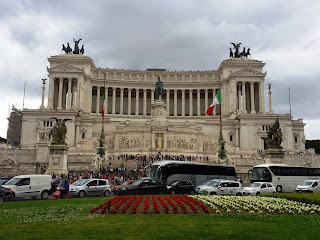From here it is a pleasent 1 hour train ride to Rome (12 euros for a return ticket).
Rome is the capital of Italy and region of Lazio. With 2.9 million residents in 1,285 km2 (496.1 sq mi), it is also the country's largest and most populated comune and fourth-most populous city in the European Union by population within city limits. TheMetropolitan City of Rome has a population of 4.3 million residents. The city is located in the central-western portion of theItalian Peninsula, within Lazio (Latium), along the shores of Tiber river. Vatican City is an independent country within the city boundaries of Rome, the only existing example of a country within a city: for this reason Rome has been often defined as capital of two states.
Rome's history spans more than two and a half thousand years. While Roman mythology dates the founding of Rome at only around 753 BC, the site has been inhabited for much longer, making it one of the oldest continuously occupied cities in Europe. The city's early population originated from a mix of Latins, Etruscans and Sabines. Eventually, the city successively became the capital of the Roman Kingdom, the Roman Republic and the Roman Empire, and is regarded as one of the birthplaces of Western civilization. It is referred to as "Roma Aeterna" (The Eternal City) and "Caput Mundi" (Capital of the World), two central notions in ancient Roman culture.
After the fall of the Empire, which marked the beginning of the Middle Ages, Rome slowly fell under the political control of thePapacy, which had settled in the city since the 1st century AD, until in the 8th century it became the capital of the Papal States, which lasted until 1870.
Beginning with the Renaissance, almost all the popes since Nicholas V (1422–55) pursued coherently along four hundred years an architectonic and urbanistic program aimed to make of the city the world's artistic and cultural center. Due to that, Rome became first one of the major centers of the Italian Renaissance, and then the birthplace of the Baroque style. Famous artists and architects of the Renaissance and Baroque period made Rome the center of their activity, creating masterpieces throughout the city. In 1871 Rome became the capital of the Kingdom of Italy, and in 1946 that of the Italian Republic.
Rome has the status of a global city. In 2011, Rome was the 18th-most-visited city in the world, 3rd most visited in theEuropean Union, and the most popular tourist attraction in Italy. Its historic centre is listed by UNESCO as a World Heritage Site. Monuments and museums such as the Vatican Museums and the Colosseum are among the world's most visited tourist destinations with both locations receiving millions of tourists a year.













No comments:
Post a Comment